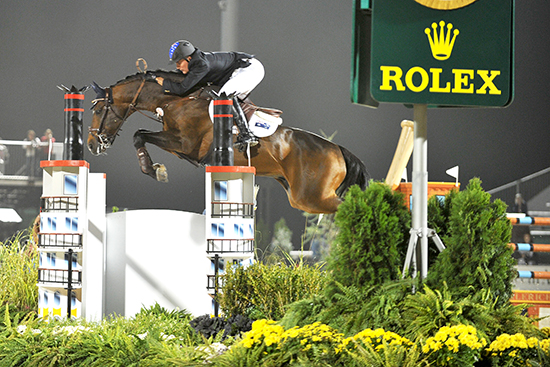 Story: Chris Hector Photos: Roz Neave & Roger Fitzhardinge
Story: Chris Hector Photos: Roz Neave & Roger Fitzhardinge
In this our final episode tracing the showjumping career of Chris Chugg, we celebrate his triumph at the World Equestrian Games in Lexington…
With a seventh place at the World Cup final in Geneva in 2011, Chris Chugg and Vivant were stars on the European circuit. The Chuggs based themselves in Germany at the home of Guido Klatte…
After the World Cup you were you always going to stay on in Europe in the run up to Lexington?
“That was the plan. Being able to go back to Guido’s was really good because we had a great place for the horse where he could just relax. He had a 60m x 60m sand yard. The horse would come home Sunday night from the show, we’d put him in the yard for three days and not touch him. Then I’d give him three days’ work and I’d go to the next show.”
“We did two shows a month. When we did compete, he’d win or get placed in a five-star show and people started wanting to know what was the secret behind how this horse was jumping so well and where did he come from. They used to ring Guido up and ask how does he train this horse? And he said, ‘I’ll tell you what he does, he brings the horse home and lets the horse have a fun time in the yard, get dirty and roll for three days. He gives him a lunge the first day and then he rides him for ten minutes, then he does flat work for three days and does a couple of bounces and then he goes to the show. That’s it. That’s his whole routine.’ And they didn’t believe it, and actually I got some bad PR over there. A German magazine wrote: ‘Can somebody please rescue this horse from Chris Chugg?’ I was a bit shocked. I didn’t reply to it. I didn’t think it needed a reply. A few people replied on my behalf.”
“Guido’s was a great base to stay because he organised my transport, he organised my paperwork; all the horror stories you hear about never happened to us because I always had great transport. Helen and I leased a truck from Jayco Horse Trucks. He was a fabulous guy to lease the truck off, and we had a six-horse truck with a great living area in it. So we lived it, when it was a five-star show we lived in the truck and, we lived in it at Guido’s as well. We transported Vivant, we fed him, we did his box. The horse was never left alone for more than two hours a day, because we knew what the horse was like. It would be like leaving a 16-year-old boy home with the keys in the car and telling him not to go near it. Temptation was far too much for that horse.”
What was it like when you arrived at Lexington? Things were pretty chaotic in the first few days of the week, weren’t they?
“I was lucky; I flew in with the horse. I know some of the grooms had a hard time, I didn’t get to see where they were staying, our groom, Amanda Madigan lived with us and travelled with us and stayed in motels with us the whole way. We couldn’t afford to have a sick groom or a tired groom or one with influenza or a bad attitude.”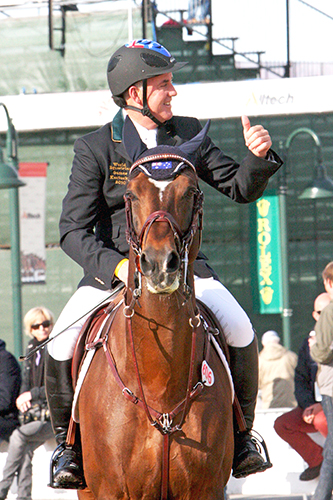
“We had a great trip over. I flew with Wirragulla Nicklaus and Vivant. Nicklaus arrived with a temperature so we dripped him and got him back on his feet again and he got healthy very quickly, he didn’t do a lot of eating and drinking on the plane. Vivant was more experienced in travelling and he could sleep and eat and drink. So he wasn’t a problem.”
“The jumping stewards didn’t like me because I built this long line of every fence I could build in a straight line. When Pessoa came out to the Sydney Olympics, he had a triple-bar, he had an oxer, a double of oxers; he had a vertical to a triple bar to a double of verticals to a Liverpool all in a straight line. Pessoa had every fence that was going to be on course put in a straight line with related distances. The exercise was just basically re-balancing the horse, giving it some natural balance and keeping it careful. We love bounces, so I built a line of bounces down to an oxer to a line of bounces to a double of verticals. But the stewards had the fences set up where they could sit down in the shade and have lunch and watch the them.”
“We set up the line and jumped three times up and down the line and went in the class. Vivant jumps good fresh. I like to take my horses in with very few practice fences and if there’s a mistake to be made it happens in the ring, and that’s a great learning curve.”
“I had a time fault, then they adjusted the time so it was okay. I knew where I got my time fault. I wanted to do one less stride down to Fence Two, which I think had the black Spanish bulls on the side. I wanted to go down in seven, everyone was going to ride eight and nine and I said to George Morris, ‘I can get seven down there.’ Then you had to turn back to a vertical, a style, and get a forward line up to a triple bar and I thought, ‘No, don’t do one of your big Chuggy misses, don’t come down here and ride off your eye.’ So I made one extra stride, but by the time I’d finished coming out of the ring they amended the time and I didn’t have a time fault. So I was on clear, we were rapt.”
“The WEG was great, I kept my concentration right up until the final round, the individual. When I went out to walk the individual track they let everybody, all the spectators, on course. It was like a rabbit plague and I couldn’t get the feel of the course. You couldn’t see where the flow and the lines were on the course. Plus, the bloody horse recovered more than I thought he would, we thought he’d be a bit tired. He jumped a fantastic first round in the individual and we took him back to the stables. He had a feed, had two hours sleep and it was like riding him with four days off. So he was playing games cutting corners, and I didn’t really have a great game plan.”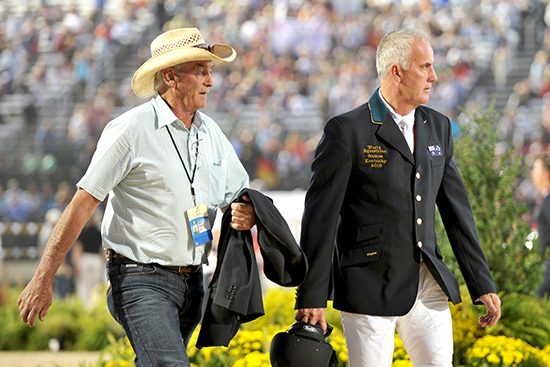
“It was a very simple track, it was a bit like a top score. There was a fence here, there was a fence there, all the technical side of it had gone off. The course designer had just excelled himself right through the team event and leading up to the individual, but the actual individual second round was very basic. Very set out, not technical and I didn’t think it was a tough as what actually it was. I came inside a couple of lines and Vivant had a very naughty habit of curling around your right leg. He loved to curl around your inside leg and virtually do quarters-in coming to a fence. And he was a horse that needed to be square to a fence rather than be a little bit off with his hindquarter. I had four faults at fence four and then he jumped the second-last fence and I was a bit long to it and he landed and drifted a little off to the right. So as much as I was really happy with the horse I was a little disappointed in that. And that’s something that I won’t let happen again, I’ll make sure it doesn’t.”
It must have been a heart wrenching decision to sell the horse?
“It wasn’t an easy decision to sell him, but it was an easy decision to be made when I saw what was in front of me for the next 15 months to get ready for London. When I went across I ranked 265 in the world and after WEG, I was about 87. Before the WEG, it wasn’t too hard to get into the big competitions, but after Lexington, we had to compete in the World Cup and it’s a lot harder to get starts at the World Cup shows.”
“As soon as the new season started, I was relegated to the rider tour shows, which is a fabulous run of shows to do, but they were not shows where you could make enough money which would warrant keeping a horse of his quality for 15 months in Europe. We had won good prize money in Europe, but we spent the whole lot of it straight after WEG doing three-star shows that you have to pay to go to. You have to pay your own accommodation, you have to pay your own transport. The future for Vivant, who is really a five-star horse and shouldn’t be started at anything under five star, was going back and having to compete Thursday and Friday at three-star shows to qualify for the Grand Prix on Sunday. We didn’t want a horse that was going to get to the Games because we were taking advantage of him for the next 15 months. We couldn’t afford to have a horse that wasn’t sound at the end of the 15 months.”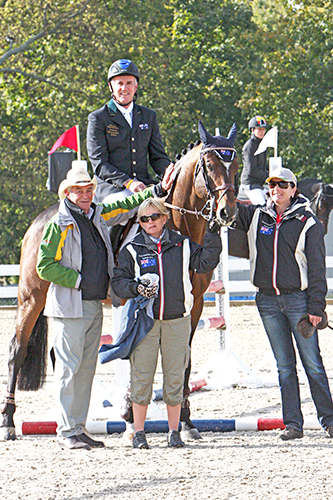
The team coach Rod Brown, Helen, and Amanda Madigan
“I don’t really like Europe with the changes of climate. The winter is nine months of the year. The summer is three months and it’s not really a summer. I would be there with one horse and to get in the top 50, I would have had to turn him into a speed horse and I wasn’t prepared to do that to him.”
“There were a lot of people who wanted to buy him, but unfortunately the richest ones are the amateurs. The French guy, Rothschild, was the richest amateur and he wanted to buy the horse, but he wasn’t a good enough rider. I couldn’t have slept at night knowing that he had a rider who couldn’t really ride at three-star level, would miss, and the horse had too big a heart to do that to him.”
“I was very lucky that in the end it became very easy because Aleksandr Orishenko wanted to buy him. He’s a very good amateur rider; he has great trainers. He doesn’t miss. He doesn’t ask too much of his horses. The horse would want for nothing, vet-wise, training-wise and I had a sneaking suspicion that Katharina Offel was going to ride him. And Katarina had seen him and funnily enough, every time we went to a show prior to Lexington we were stabled next to Katharina so we got to know her and we knew that she loved her horses and she looked after them and she loved Vivant.”
“I sold the horse to Aleksandr. I went down to his stables for seven days and gave him lessons on the horse. Introduced the groom to everything Vivant likes and dislikes and be careful because he’s a naughty boy, he can do this, he can do that. He rode the horse and then he employed Henk Nooren as his trainer. So I had a word to Henk and explained what the horse likes. I was very happy in leaving him in their hands.”
“Aleksandr wanted to give the horse a big holiday after the WEG and I told him how the horse gets lots of breaks, doesn’t need much jumping at home, definitely needs no heavy schooling. He took Vivant on the Tuscany tour, so Helen and I flew over there for a holiday and to watch him go and he rode the horse perfect. But the horse had come out of living an Australian lifestyle of being a breeding stallion, sniffing the spring air, being the number one horse on a property. Suddenly he was living in a stable where he was turned into a European horse. He lost all his characteristics of being flamboyant, noisy, cheeky … he was just like a gelding. He got a little bit like a battery hen.”
“It took him a day and a half to know Helen and me, and much to their groom’s annoyance, he got lots of licorice and lots of carrots every day. And we’d play with him and he’d get precocious, and then he’d see you coming down the stable block and you could whistle and he’d whinny to you. But he was a horse that would spot me at eleven o’clock at night coming down the driveway and he’d just start whinnying. It took us a day and a half to bring him back and much to the groom’s outrage we turned him back into the brat he always was.”
“Katharina got the ride on the horse and did some very great classes with him but for one reason or another the partnership broke up, I don’t know why. I quickly sent Aleksandr a text and said that I’d be very happy to ride for the Ukraine… I thought, well, if he’s going to employ another rider to ride the horse, there’s probably no better combination than me and the horse. So I sent him a text, a cheeky text, to see if it worked. It didn’t work.”
Latest news going around show jumping circles is Katharina has the ride on Vivant again.
For Chris and Helen the new bloodline in their program comes in the form of Bodycheck, now re-named Baluga, by Balou de Rouet out of a Carismo mare:
“He arrived in February to stand at stud and breed. So we’re going to cover all our mares later in the season around February, March, April, and so he’ll be put over the Vivant-Conquistador fillies. He’s already got four foals on the ground in Germany, I understand.”
“Before he was sold at the auction, I had Guido Klatte look at the horse for me and his son, Junior Guido who’s the German Junior Showjumping Champion at the moment, I trained him when I was over there for the year and he’s a great young rider. And they watched the horse get trialed every day in the run up to the auction.”
“Schockemöhle wanted the horse, a Ukraine buyer wanted the horse, and a businessman who always buys the top sale stallions from Klatte’s stud, wanted the horse. I said, ‘you watch the horse every day trialed, what does he jump like?’ Guido said, ‘He reminds us so much of Vivant that it’s not funny’. That was good enough.”
Do you have the energy to make another superstar?
“I think I’ve got enough energy. I’m looking to make another three or four. I’m 51 now, and I’m aiming to be riding around at 65 at least.”
“The breeding program that we’ve got going means that the foals that are born this year and the foals that are born next year, aren’t going to be really ridden and in competition for another six years. I think that I’m never going have to worry about the quality of horses that I ride. I’m going to make a conscious effort of staying fit and healthy, and reinvesting in good quality horses. With the stock that we’ve got at home with the breeding program, for sure, there’s going to a Vivant that comes out of one of those.”
I think you’re riding better than you’ve ever ridden before. Is it harder to keep the body in shape?
“You just realise that you can’t go as hard as you used to; you can’t drink as much, you can’t eat as much. It’s a good telltale sign when you ride a four-year old and it turns right and you want to turn left. Or you go to put your socks on in the morning and your feet don’t quite come up high enough.”
“So I swim and I stretch and we’re very conscious now of what we eat; there’s no McDonalds, there’s no fast food. It’s a young person’s sport and it is getting tougher. There are lots of people out there going overseas to buy horses and they’re not buying four-year-olds, they’re buying seven- and nine-year-old horses who are jumping 1.45m, coming back as serious competitors, and they’re under 25.”
“The sport is definitely going to get bigger. They’ve got sponsors, where I never had sponsors. It’s a sponsored style of lifestyle now because it is a very expensive exercise when you have to import horses, go overseas and buy horses. When we went across and bought horses we couldn’t afford to make a mistake in what we purchased. Flying back the horses is so much money it’s not funny. And purchasing the horse is really expensive, so we have to make sure that what we have bought is going to fill our team for the next ten years and it has. I think eight out of 13 horses we purchased for the Barreras were all placed in the World Cups. Six have won World Cups, eight have placed in World Cups and we had three injuries that never got to be ridden. There are others like Hilary Scott’s French mare, Oaks Miss Scarlett who won the World Cup at Tonimbuk. We bought her as a three-year-old in France.”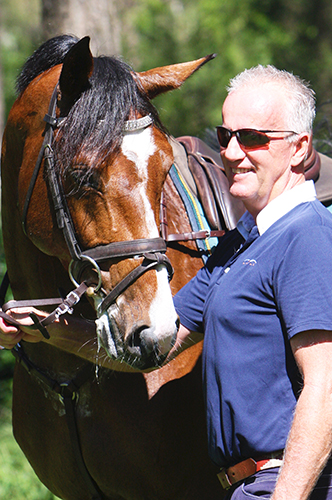
Is it still a buzz for you, or do you wake up some mornings feeling, another day, I’d rather go back to sleep…
“It’s a big buzz and if I had an open cheque book I’d still go about it the same way. I’d still buy young horses and I’d still want to breed my own young horses. The reality is that Europe is such a marketplace you can actually go and buy yourself a superstar at three and four years old. But there’s no superstars that you’re going to buy at five, six and seven because the market is so strong over there. Those countries have Nations Cups Showjumping teams and an Olympic Games team and getting into those teams means as much as winning Wimbledon or the Masters Golf Tournaments, and they will spend the money so that their sons can do it and their daughters can do it.”
“There’s no way in the world that you’re to go and buy a six-year-old Totilas. There’s no way you’re going to go and buy a seven-year-old Vivant, without spending from 1,000,000 Euros to 8,000,000 Euros, you won’t buy one. The only way you can do it is to go over and buy stock that haven’t really been seen, never been jumped under saddle. That’s what I would prefer to buy, I’d prefer to jump the horse myself first, and go to places and select a horse even before it has gone to the breakers. And to us, that’s a big achievement when you have something like Vivant turn up and get to the end of it. When you buy them really young then you have the chance of a superstar.”
Isn’t it hard to come back to Australia? You’ve gone over there, you’ve jumped at all those fabulous big shows with all that prize money and here you are in some dusty bloody paddock in the middle of nowhere, jumping for five hundred bucks…
“No, because I think this is a great training ground. This is where the horses get their experience without having pressure on them. We don’t have to cook young horses for four-year-old classes. We don’t have to cook five-year-olds for five-year old classes. When I was in Germany I was watching five, four, five and six-year-olds getting trained on Monday to go to a competition on Tuesday, Wednesday and Thursday and then another show on Saturday and Sunday so they could get qualified to go to the Bundeschampionate.”
“That sort of pressure would never have developed a Vivant, a Scandal or a Currency. And that’s something that I know, that the only pressure I put on the horses at a show is to stay straight, and by Sunday be jumping better than Friday. I don’t want a horse jumping good on Friday and to be nervous Sunday. Go to the show and use it as a training ground, and that’s what we do. We never go to a show ready to win the battle but lose the war…”
This article first appeared in the May 2012 issue of THM.
For more articles with Chris Chugg, go to:
